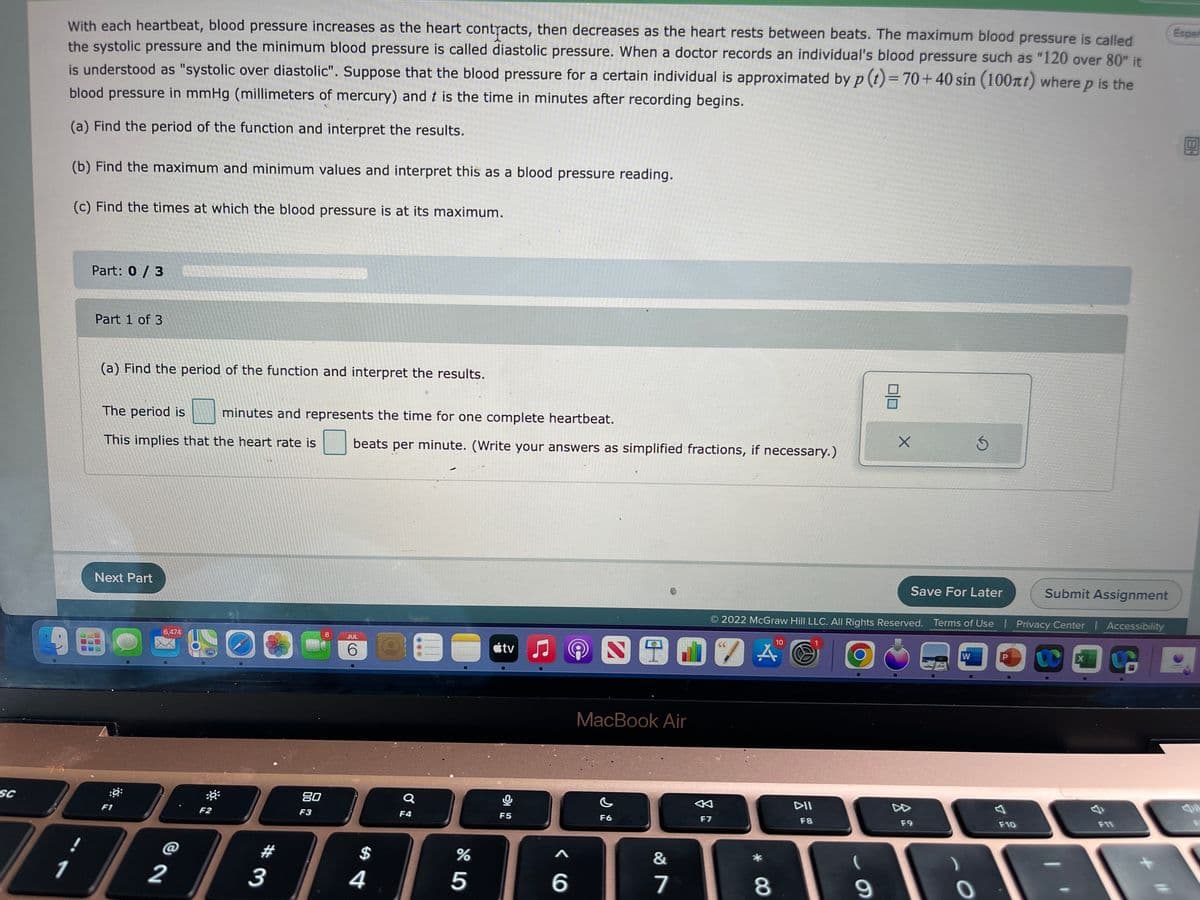With each heartbeat, blood pressure increases as the heart contracts, then decreases as the heart rests between beats. The maximum blood pressure is called the systolic pressure and the minimum blood pressure is called diastolic pressure. When a doctor records an individual's blood pressure such as "120 over 80" it is understood as "systolic over diastolic". Suppose that the blood pressure for a certain individual is approximated by p (t)= 70+40 sin (100xt) where p is the blood pressure in mmHg (millimeters of mercury) and t is the time in minutes after recording begins. (a) Find the period of the function and interpret the results. (b) Find the maximum and minimum values and interpret this as a blood pressure reading. (c) Find the times at which the blood pressure is at its maximum. Part: 0/3 Part 1 of 3 (a) Find the period of the function and interpret the results. The period is This implies that the heart rate is minutes and represents the time for one complete heartbeat. beats per minute. (Write your answers as simplified fractions, if necessary.) X S
With each heartbeat, blood pressure increases as the heart contracts, then decreases as the heart rests between beats. The maximum blood pressure is called the systolic pressure and the minimum blood pressure is called diastolic pressure. When a doctor records an individual's blood pressure such as "120 over 80" it is understood as "systolic over diastolic". Suppose that the blood pressure for a certain individual is approximated by p (t)= 70+40 sin (100xt) where p is the blood pressure in mmHg (millimeters of mercury) and t is the time in minutes after recording begins. (a) Find the period of the function and interpret the results. (b) Find the maximum and minimum values and interpret this as a blood pressure reading. (c) Find the times at which the blood pressure is at its maximum. Part: 0/3 Part 1 of 3 (a) Find the period of the function and interpret the results. The period is This implies that the heart rate is minutes and represents the time for one complete heartbeat. beats per minute. (Write your answers as simplified fractions, if necessary.) X S
Algebra & Trigonometry with Analytic Geometry
13th Edition
ISBN:9781133382119
Author:Swokowski
Publisher:Swokowski
Chapter7: Analytic Trigonometry
Section7.6: The Inverse Trigonometric Functions
Problem 74E
Related questions
Question

Transcribed Image Text:SC
With each heartbeat, blood pressure increases as the heart contracts, then decreases as the heart rests between beats. The maximum blood pressure is called
the systolic pressure and the minimum blood pressure is called diastolic pressure. When a doctor records an individual's blood pressure such as "120 over 80" it
is understood as "systolic over diastolic". Suppose that the blood pressure for a certain individual is approximated by p (t)= 70+40 sin (100m) where p is the
blood pressure in mmHg (millimeters of mercury) and t is the time in minutes after recording begins.
(a) Find the period of the function and interpret the results.
(b) Find the maximum and minimum values and interpret this as a blood pressure reading.
(c) Find the times at which the blood pressure is at its maximum.
1
Part: 0/3
Part 1 of 3
(a) Find the period of the function and interpret the results.
The period is
This implies that the heart rate is
Next Part
F1
6,474
2
280
F2
minutes and represents the time for one complete heartbeat.
O
3
80
F3
8
beats per minute. (Write your answers as simplified fractions, if necessary.)
JUL
6
$
4
Q
F4
%
5
tv
F5
6
10
1917 A
MacBook Air
c
F6
&
7
K
F7
66
* 00
2022 McGraw Hill LLC. All Rights Reserved. Terms of Use | Privacy Center | Accessibility
8
DII
F8
(
X
9
Save For Later
F9
Ś
W
0
Submit Assignment
F10
X
S
F11
Espar
Expert Solution
This question has been solved!
Explore an expertly crafted, step-by-step solution for a thorough understanding of key concepts.
This is a popular solution!
Trending now
This is a popular solution!
Step by step
Solved in 3 steps with 3 images

Recommended textbooks for you

Algebra & Trigonometry with Analytic Geometry
Algebra
ISBN:
9781133382119
Author:
Swokowski
Publisher:
Cengage

Functions and Change: A Modeling Approach to Coll…
Algebra
ISBN:
9781337111348
Author:
Bruce Crauder, Benny Evans, Alan Noell
Publisher:
Cengage Learning

Algebra & Trigonometry with Analytic Geometry
Algebra
ISBN:
9781133382119
Author:
Swokowski
Publisher:
Cengage

Functions and Change: A Modeling Approach to Coll…
Algebra
ISBN:
9781337111348
Author:
Bruce Crauder, Benny Evans, Alan Noell
Publisher:
Cengage Learning